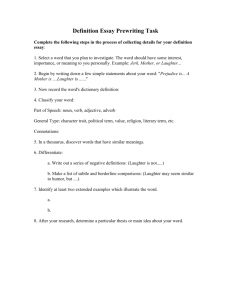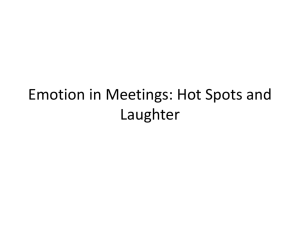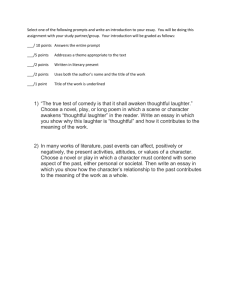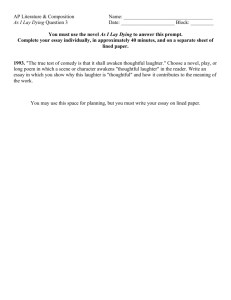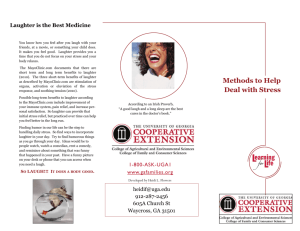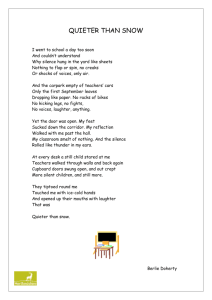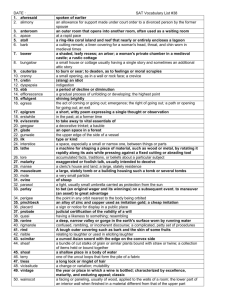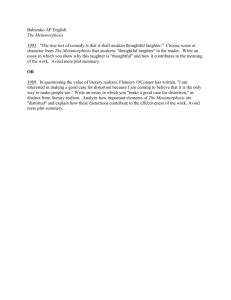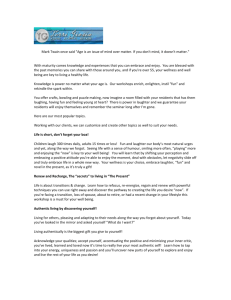Emotion in Meetings: Hot Spots and Laughter
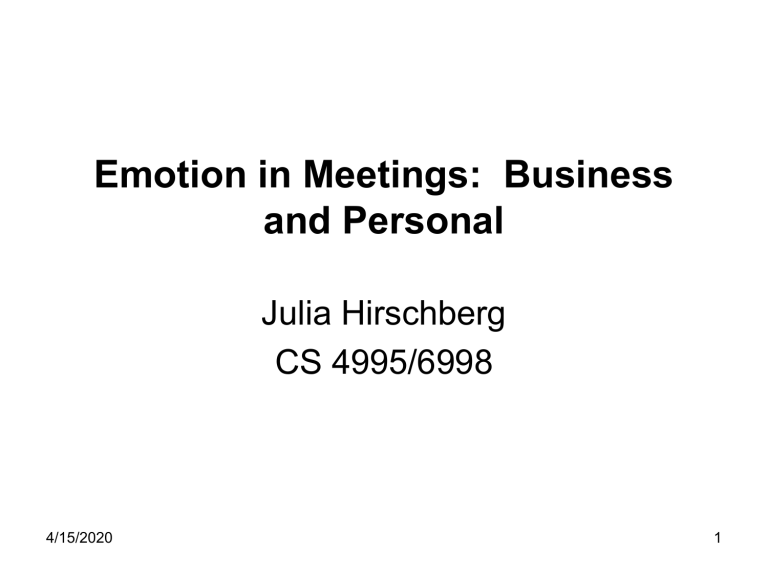
Emotion in Meetings: Business and Personal
Julia Hirschberg
CS 4995/6998
4/15/2020 1
Spotting “Hot Spots” in Meetings: Human
Judgments and Prosodic Cues
- Britta Wrede, Elizabeth Shriberg
• Can human listeners agree on utterance-level judgments of speaker involvement?
• Do judgments of involvement correlate with automatically extractable prosodic cues?
• Why might this be useful for meetings?
Corpus
• ICSI Meeting Corpus
– 75 unscripted, naturally occurring meetings on scientific topics
– 71 hours of recording time
– Each meeting contains between 3 and 9 participants
– Pool of 53 unique speakers (13 female, 40 male)
– Speakers recorded by both far field and individual close-talking microphones
• Recordings from the close-talking microphones were used here
Method
• Subset of 13 meetings (4-8 spkrs) selected
• Analyzed utterances for involvement:
– Amusement, disagreement, other
• “Hot Spots” labeled: +1 spkr had high involvement
– Labeled as amused, disagreeing, other
– Why didn’t allow context?
– Why use (9) people who know the spkrs?
– Why ask them to base their judgment as much as possible on the acoustics?
• Inter-rater agreement measured using Fleiss’ Kappa for pair-wise and overall agreement
Inter-rater Agreement
•
• Cohen’s kappa : 2 raters, categorical data
P o
15
70 / 100
.
85
Pe
[( 20 / 100 ) * ( 25 / 100 )]
[( 75 / 100 ) * ( 80 / 100 )]
0 .
05
0 .
60
0 .
65
P o
1
P
P e e
• Fleiss’ kappa : generalizes Cohen’s to multiple raters, categorical data
• Krippendorf’s alpha : measures agreement of multiple raters, any type of data
– Observed vs. expected dis agreement
1
D o
D e
Inter-rater agreement
• Nine listeners, all of whom were familiar with the speakers provided ratings for at least 45 utterances but only 8 ratings per utterance were used.
Inter-rater Agreement for Meetings
• Agreement for high-level distinction between involved and non-involved yielded a kappa of .59
(p < .01) -- reasonable
• When computed over all four categories , reduced to .48 (p
< .01)
– More difficulty making distinctions among types of involvement ( amused, disagreeing and other)
Pair-wise agreement
Native vs. nonnative raters
Acoustic cues to involvement
• Why prosody?
– Not enough data in the corpus to allow robust language modeling.
– Prosody does not require ASR results, which might not be available for certain audio browsing applications or have poor performance on meeting data
Potential Acoustic Cues to Involvement
• Certain prosodic features, such as F0, show good correlation with certain emotions
• Studies have shown that acoustic features tend to be more dependent on dimensions such as activation and evaluation than on emotions
• Pitch related measures, energy and duration can be useful indicators of emotion
Acoustic Features Examined
• F0 and energy based features were computed for each word (mean, minimum and maximum considered)
• Utterance scores obtained by computing average over all the words)
• Tried absolute or normalized values
Correlations with Perceived Involvement
• Class assigned to each utterance determined as a weighted version of its ratings
– A soft decision, accounting for the different ratings in an adequate way
• Difference between two classes significant for many features
– Most predictive features all F0 based
– Normalized features more useful than absolute features
– Patterns remain similar: the most distinguishing features are roughly the same when within speaker features are analyzed
• Normalization removes a significant part of the variability across speakers
Conclusions
• Despite subjective nature of task, raters show significant agreement in distinguishing involved from non-involved utterances
• Native/non-native differences in
• Prosodic features of rated utterances indicate involvement can be characterized by deviations in F0 and energy
– Possibly general effect over speakers
– If true, mean, variance, and baseline normalizations may be able to remove most variability between speakers
Analysis of the occurrence of laughter in meetings
-
Kornel Laskowski, Susanne Burger
Analysis of the occurrence of laughter in meetings
-
Kornel Laskowski, Susanne Burger
• Questions:
– What is the quantity of laughter, relative to the quantity of speech?
– How does the durational distribution of episodes of laughter differ from that of episodes of speech?
– How do meeting participants affect each other in their use of laughter, relative to their use of speech?
Method
• Analysis Framework
– Bouts, calls and spurts
– Laughed speech
• Talk spurt segmentation
– Using word-level forced alignments in ICSI Dialog Act
(MRDA) Corpus
– 300 ms threshold, based on value adopted by the
NIST Rich Transcription Meeting Recognition evaluations
• Selection of Annotated Laughter Instances
– Vocal sound and comment instances
• Laugh bout segmentation
– Semi-automatic segmentation
Analysis
• Quantity of laughter
– Average participant vocalizes for 14.8% of time spent in meetings
– Of this time, 8.6% spent on laughing and additional
0.8% spent on laughing while talking.
– Participants differ in how much time spent vocalizing and on what proportion of that is laughter
– Importantly, laughing time and speaking time do not appear to be correlated across participants.
Analysis
• Laughter duration and separation
– Duration of laugh bouts and temporal separation between bouts for a participant?
– Duration and separation of “islands” of laughter , produced by merging overlapping bouts from all participants
– Bout and bout “island” durations follow a lognormal distribution , while spurt and spurt “island” durations appear to be the sum of two lognormal distributions
– Bout durations and bout “island” durations have an apparently identical distribution , suggesting that bouts are committed either in isolation or in synchrony, since bout
“island” construction does not lead to longer phenomena .
– In contrast, construction of speech “islands” does appear to affect the distribution , as expected.
– Distribution of bout and bout “island” separations appears to be the sum of two lognormal distributions .
Analysis
• Interactive aspects(multi-participant behavior)
– Laughter distribution computed over different degrees of overlap
– Laughter has significantly more overlap than speech; in relative terms, ratio is 8.1% of meeting speech time versus 39.7% of meeting laughter time
– Amount of time spent in which 4 or more participants are simultaneously vocalizing is
25 times higher when laugher considered
– Exclusion and inclusion of “laughed speech”
Interactive aspects(continued…)
• Probabilities of transition between various degrees of overlap:
Conclusions
• Laughter accounts for ~9.5% of all vocalizing time, which varies extensively from participant to participant and appears not to be correlated with speaking time
• Laugh bout durations have smaller variance than talk spurt durations
• Laughter responsible for significant amount of vocal activity overlap in meetings, and transitioning out of laughter overlap is much less likely than out of speech overlap
• Authors quantified these effects in meetings, for the first time, in terms of probabilistic transition constraints on the evolution of conversations involving arbitrary numbers of participants
